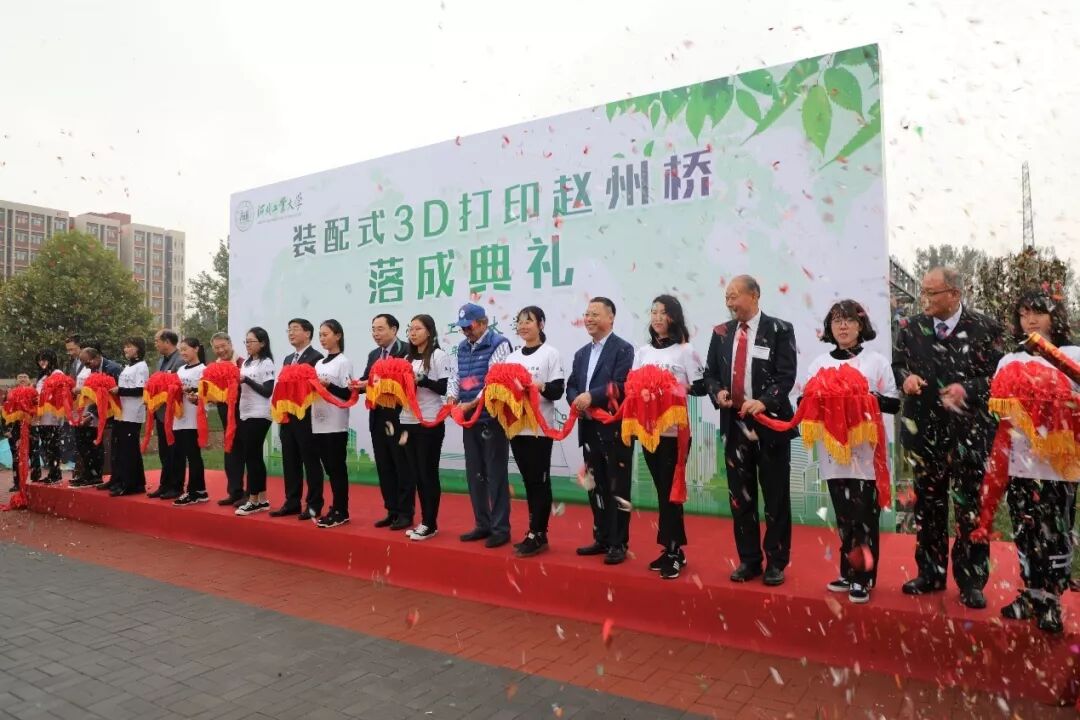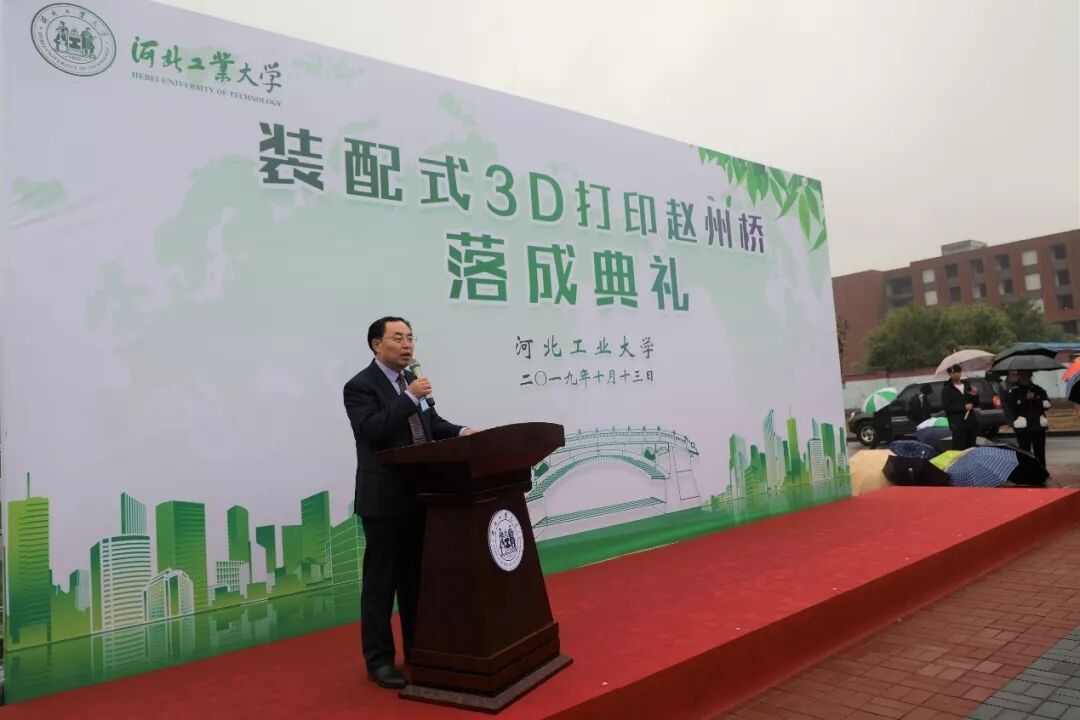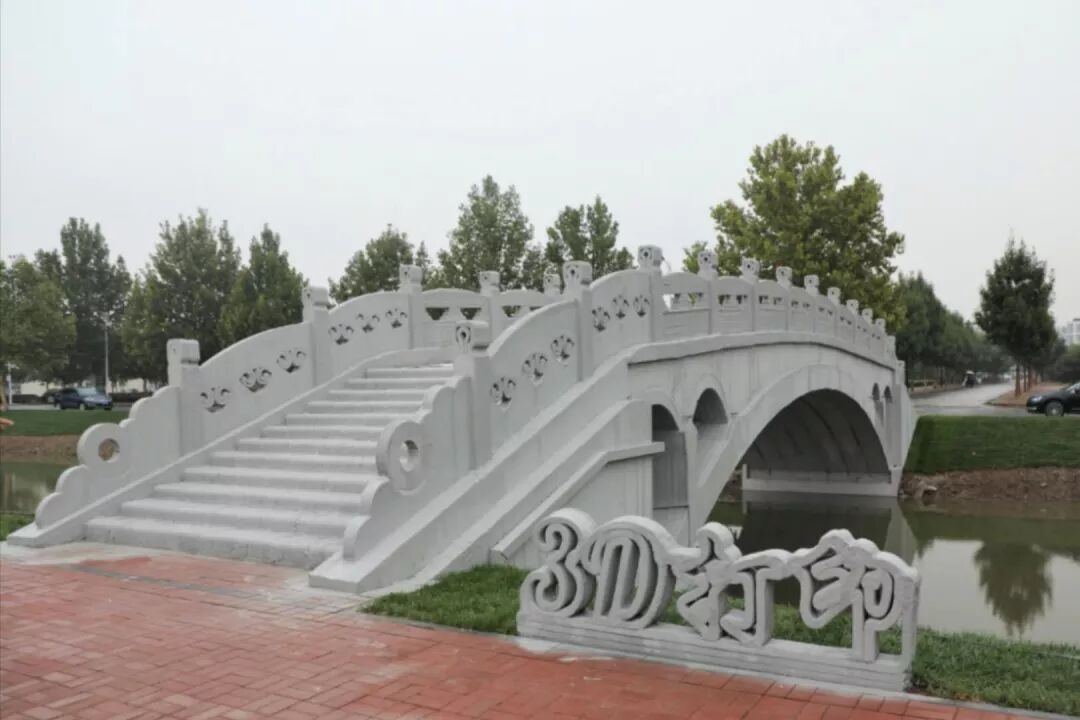On the afternoon of October 13, the prefabricated 3D printed Zhaozhou Bridge, completed by Professor Ma Guowei, Vice President of our university and Dean of the School of Civil Engineering and Transportation, was inaugurated at our Beichen campus. Professor Han Xu, Vice Secretary of the Party Committee and President of the university, along with over 150 scholars from 10 countries and regions, attended the inauguration ceremony.

Ceremony for the inauguration of the prefabricated concrete 3D printed Zhaozhou Bridge
During the ceremony, Ma Guowei stated that 3D printing, as an emerging technology, represents a completely new and disruptive construction model. The prefabricated concrete 3D printed Zhaozhou Bridge draws on the construction experience of completed 3D printed buildings, incorporates BIM virtual simulation technology, modern intelligent monitoring methods, and employs modular printing technology to optimize the design of node assembly forms, enabling on-site prefabricated construction. This modernizes traditional bridges, fully realizing the new design, functional materials, virtual construction, modular assembly, and intelligent monitoring, marking an important step for our university in successfully applying the concept of green intelligent construction in the path of industry-university-research collaboration.

At the inauguration ceremony of the prefabricated concrete 3D printed Zhaozhou Bridge, Professor Ma Guowei, Vice President of Hebei University of Technology and Dean of the School of Civil Engineering and Transportation, introduced the relevant information about the prefabricated concrete 3D printed Zhaozhou Bridge to guests from home and abroad.
Concrete 3D printing is a new additive manufacturing technology that stacks cement-based composite materials layer by layer. Due to its advantages of moldless, automated, rapid, and flexible construction, it has rapidly emerged in fields such as architecture, bridges, and infrastructure, showing great development potential. 3D printing is a mold-free rapid construction process that allows for the quick and flexible construction of irregular concrete structures and buildings without the need for template support. The design options are more flexible, and special textures can be used in printing to give buildings unique surfaces. It can also be applied in the preservation of ancient buildings, accurately restoring damaged or missing parts. The overall design of the bridge railing conforms to the curve of the Zhaozhou Bridge’s openings, and elements of peach blossoms are incorporated into the bridge deck and railing, symbolizing the flourishing of education. Additionally, the railing features inscriptions of the years 1903, 1912, 1929, 1952, 1995, and 2019, symbolizing the school’s 116 years of development.

The prefabricated concrete 3D printed Zhaozhou Bridge stands tall at the Beichen campus of Hebei University of Technology.
Compared to traditional construction methods, 3D printing eliminates the need for templates and supports, saving approximately one-third of construction materials and two-thirds of labor. The highly automated printing process can significantly improve construction efficiency and is an innovative technology driving the development of prefabricated buildings and intelligent construction. This technology can greatly enhance construction efficiency without increasing costs due to the geometric complexity of structures; it can also significantly reduce environmental pollution on-site, making it a revolutionary technology for advancing prefabricated buildings and intelligent construction. During the 3D printing process of the bridge, many sensors were embedded for 24-hour health monitoring of the bridge, allowing for timely detection and resolution of stress-related issues, ensuring safety while also reflecting intelligent integration. The development of intelligent construction centered on 3D printing technology can promote the construction industry towards greener, industrialized, and intelligent directions, aiding the national process of construction industrialization.

Professor Behrokh Khoshnevis from the University of Southern California, Chief Engineer Han Zhenyong from Tianjin Urban Construction Group, Professor Victor C.Li from the University of Michigan, Chief Engineer Li Jiulin from Beijing Urban Construction Group, Professor Jay Sanjayan from Swinburne University of Technology in Australia, and General Manager Wang Changke from the Northern Design Engineering Research Institute all spoke to congratulate the completion of the prefabricated 3D printed Zhaozhou Bridge, expressing that it has epoch-making significance for advancing key technologies in intelligent construction and achieving the green, industrialized, and intelligent processes in China’s construction industry.

Welcome to like and shareFor reprints, please contact for authorizationClick to see more articles The second “International Conference on Architectural 3D Printing” hosted by our university opened in Tianjin. Our university held a ceremony for the appointment of honorary and part-time professors and the unveiling of the Health Science and Engineering Research Center.Text: Cui YunfeiImages: Tu Qiongfang, Huo ZhanliangUnit Review: Qing LongbangTypesetting: Su ZhiyuanSupervision: Chen ZhaochunReviewed by: Huo ZhanliangProduced by the Media Center
